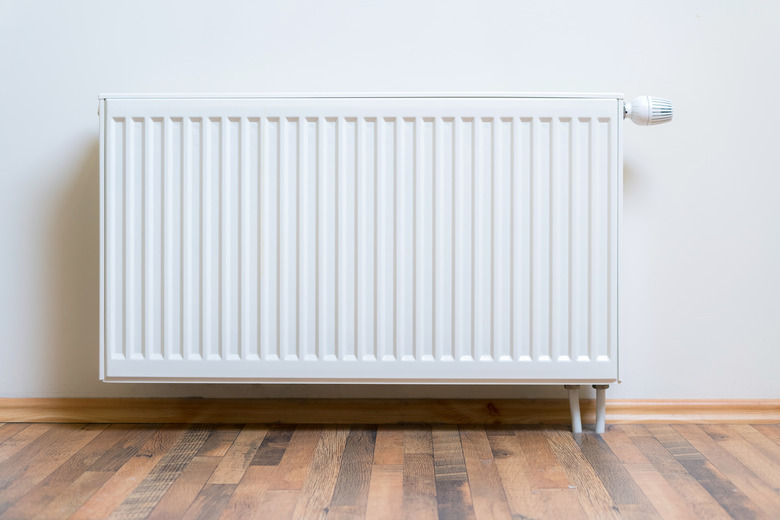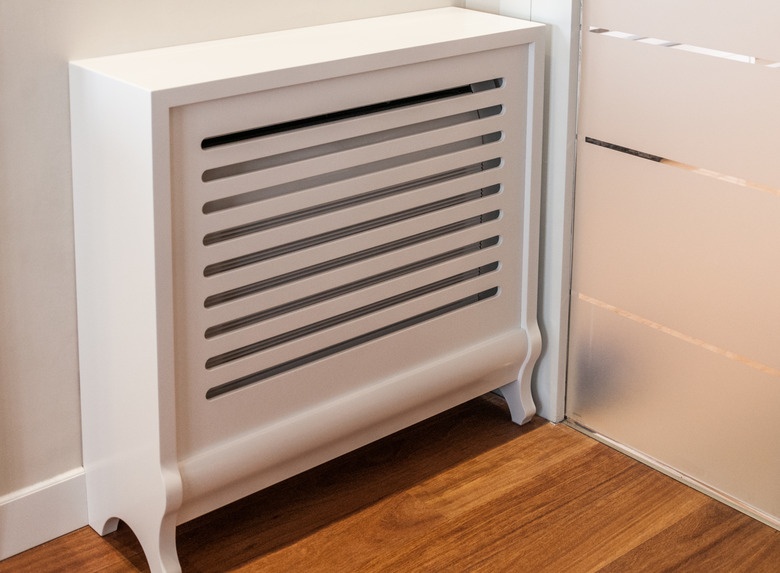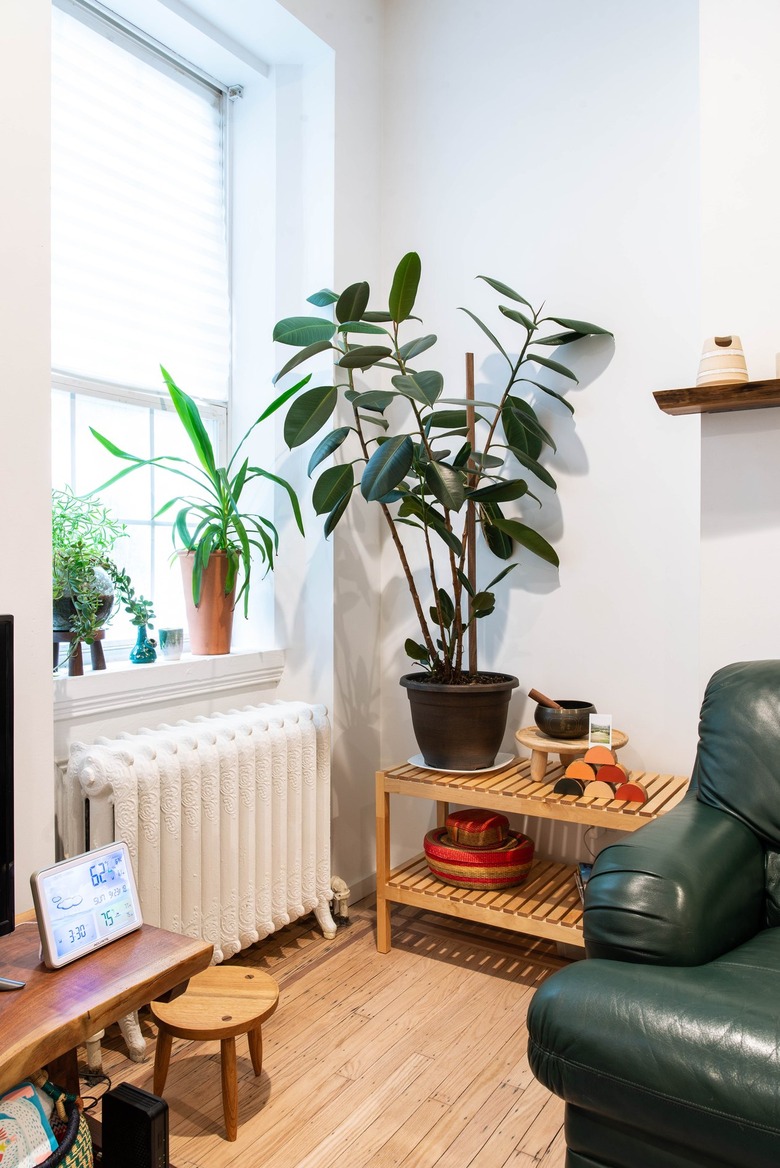Need To Replace Your Home Radiator? Here's What You Need To Know
We may receive a commission on purchases made from links.
Although it's not a common project, removing and replacing a radiator for a hot water or steam boiler heating system may come up from time to time. Generally speaking, it's a job for a professional heating contractor, though a skilled DIYer can sometimes do it provided the system is not too complicated.
A very basic one-pipe radiator with a simple hand valve is not very complex, and a DIYer may be able to tackle replacement, though it can be a physically challenging job. A two-pipe steam radiator with a thermostatic inlet valve and a steam vent can be more complicated to install. If you are changing radiator styles — installing more stylish flat-panel radiators, for example — there can be considerable plumbing or carpentry work.
Why might you need to replace a hot water or steam radiator? There are several reasons.
Reasons for Replacing a Radiator
Reasons for Replacing a Radiator
There are several scenarios in which you might need to remove and replace a radiator:
- First, it's possible that the radiator is simply worn out. Cast iron radiators can rust from the inside out, and when a radiator begins to develop pinhole leaks, there's little option but to replace it.
- Your radiator may not be big enough to supply the heat a room needs, requiring that you replace it with a larger model.
- Perhaps the style of the radiator is unbearably old-fashioned to you. Manufacturers today make a variety of designer radiators, such as flat-panel designs that look more like wall art than functional radiators.
- Finally, it's possible you simply need to remove the old radiator temporarily so that you can make wall repairs or paint the walls.
Whatever the reason for removing and replacing a radiator, the process looks much the same. Before you do so, make sure there are no other easier solutions to fix the problem at hand.
Repairs to Try Before Replacing
Repairs to Try Before Replacing
When a radiator stops producing sufficient heat, there are a number of fixes you can try to correct the issue.
All radiators have some form of bleed valve or air vent. In the case of hot water boilers, this is a bleed valve located at one end of the radiator near the top. This valve allows you to bleed air out of the radiator to allow hot water to flow freely. Bleeding a radiator of excess air is the first thing to try with a hot water radiator.
Steam radiators are fitted with an air valve that is designed to release cold air inside the radiator so that hot steam can rise up from the boiler to heat the room. The valve is a heat-sensitive device that closes down as soon as it senses the heat from the steam, but if it malfunctions, it may refuse to open or close. Either way, the result is a radiator that doesn't do its job. Replacing the valve often restores the radiator's heating ability.
Finally, there are the radiator's main valves. In some cases, the hot water or steam flowing into the radiator is controlled by a simple hand valve with a turn knob, while in other cases, there may be a thermostatic valve or lockshield valve that controls the flow in and out of the radiator. These valves can fail, and replacing them is generally easier and much cheaper than replacing the entire radiator.
It's also possible that the radiator has become filled with sludge and therefore can no longer heat efficiently. If this happens, the fix is to take the radiator outdoors, remove its valves and flush it thoroughly with water to clean it out before reinstalling it.
Steam Radiator vs. Hot Water Radiator
Steam Radiator vs. Hot Water Radiator
Before replacing a radiator, you'll need to identify whether you have a steam system or hot water system radiator. The different system designs call for different radiators.
In a steam boiler system, the top of the boiler, the pipes and the radiators themselves are filled with hot vapor that rises up into the radiators from the boiler. An air valve on the radiator vents the excess air until it senses that expanding steam has filled the radiator and then closes to allow the radiators to warm up and heat the room. As the steam gives up its heat and cools, it condenses back into water and runs back down the pipes to return to the boiler. In steam systems, there can be either one or two pipes connected to the radiator.
You can identify a steam boiler by the presence of a sight glass at the boiler, which lets you monitor the level of water in the system. Steam systems are not very common in today's homes, though you may find them in pre-1930s homes that haven't been updated.
Hot water boiler systems are more common, partly because they offer more accurate control of the heat. Hot water systems can also be either one-pipe systems or two-pipe systems. In one-pipe systems, the hot water circulates up into the radiator and flows back down to the boiler once it cools through the same pipe. In two-pipe systems, the water inlet is found at one end of the radiator near the bottom, controlled by some kind of hand valve or thermostatic valve. A second pipe at the other end of the radiator carries cooled water back down to the boiler. With a hot water boiler, there will be no sight glass at the boiler, but the system will be fitted with an expansion tank, usually located somewhere above the boiler.
It's generally fairly easy to identify whether you are dealing with a hot water or a steam system, but if you have doubts, consult a heating specialist.
Choosing the Right Radiator
Choosing the Right Radiator
New radiators come in many styles, from classic designs that mimic the look of vintage freestanding radiators to designer flat-panel models that don't even look like radiators at first glance. Any of these will normally work for replacement provided it is designed for your boiler style — hot water or steam. Make sure you know what type of system you have when shopping for a new radiator.
The physical size of the new radiator is of course important. It must fit the available space in the room, but it's equally important that the new radiator has a thermal rating appropriate for the needs of the room. New radiators will generally carry a British thermal unit (Btu) rating, so choosing the right radiator is a matter of making sure it meets (or slightly exceeds) the needs of the room.
An easy way to determine the heating needs of a room is to start by calculating the cubic footage of the room, which is obtained by multiplying the length by the width by the height of the space. For example, a 10 x 10 room with 9-foot ceilings has 900 cubic feet.
To this cubic foot calculation, you should then apply a multiplier based on the insulation quality of the walls: 7 for poor insulation, 5 for average insulation and 4 for excellent insulation. A 900 cubic-foot room with good insulation, then, computes as needing one or more radiators capable of producing 3,600 Btu. When you shop for a new radiator, keep these figures in mind.
There are also a number of online calculators available to estimate the heating needs of a room, many of which make adjustments for the number of windows in the room, the climate region and other factors. When you buy a new radiator, have all the room details in hand as you consult with sales staff. Modern designer radiators are often much more efficient than classic cast-iron radiators and are therefore smaller, so take into consideration any plumbing changes that may be required in order to connect a new, smaller boiler to existing pipes.
If you are buying a used radiator from a second-hand store (a good option if you desire a vintage look), you will generally do fine by buying a radiator with the same dimensions as the old one if the old one provided adequate heat. If you need more heat, though, you may want to choose a taller radiator of the same length as the old one, which will ensure that the plumbing connections line up correctly.
Radiator Installation Overview
Radiator Installation Overview
Removing and replacing a radiator can be relatively easy or quite complicated depending on the design of the system and the features of the radiator itself. With a single-pipe hot-water boiler system where the radiators are connected with just a single hand valve, replacing it with an identical or similar radiator can be done with just a couple of pipe wrenches, some pipe dope and wicking string and perhaps a new hand valve.
It becomes more complicated with a two-pipe system, in which separate pipes deliver hot water or steam to the radiator and carry cooled or condensed water back to the boiler. These two-pipe systems may have a lockshield valve instead of a thermostatic or hand valve. Usually covered with a cap, these valves can be adjusted to temperature-balance different rooms in the house, and the valve on the new radiator will need to be carefully adjusted to provide the right amount of heat. Steam radiators also have an air valve that needs to be installed during the process.
Replacement is also made more complicated if you are changing radiator styles — for example, replacing an old cast iron radiator that stands on the floor with a sleek, modern design that hangs flush on the wall. These newer radiators may require some carpentry work to anchor hanging brackets as well as some additional plumbing work to connect the existing boiler pipes to the new radiator.
Still, there are familiar basic steps that the plumber or heating technician will follow when replacing a radiator:
- Turn off the boiler and drain down the system where necessary. Steam systems may have very little water in them, though there is usually some condensation to be dealt with.
- "Break" the union fittings where the boiler pipes meet the radiator. This generally requires a couple of pipe wrenches to grip and rotate the fittings, but the process can be tricky if the radiator has been in place for many years, and the fittings are stuck with corrosion.
- Remove the old radiator. Cast iron radiators can be very heavy, so a two-wheel dolly can be helpful.
- Make any plumbing or carpentry alterations necessary. This may be needed if you are changing the size or style of the radiator. It can involve installing plumbing pipe extensions, different angle fittings or attaching wall-mount brackets if you are installing a flat-panel radiator.
- "Dress" the radiator by attaching the necessary valves. This usually requires pipe wrenches and/or tongue-and-groove pliers as well as pipe dope and perhaps wicking string. The radiator instructions will give directions for precisely how to dress the radiator.
- Move the radiator into place and secure it to the pipe unions and wall brackets (if applicable). Making union connections is often the trickiest part of the job; it can be very tricky to get the fittings to line up.
- Turn on the boiler and test the radiators for heat.
DIY or Professional Installation?
DIY or Professional Installation?
DIY installation of a steam or hot water radiator is not something homeowners should tackle unless they're very confident of their skills and physical prowess. Costs for a replacement radiator can vary greatly, from less than $100 for a salvaged cast iron radiator in decent condition to well over $1,000 for a designer flat-panel radiator. Professional installation can add at least $200 to this cost, though you can usually negotiate a discount if you are replacing several radiators at the same time.
Radiators are heavy and awkward, and the replacement can be hard work. Most people prefer to have this work done by a professional who knows the process and has the right tools.


